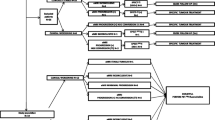Abstract
Background
Extracranial germ cell tumors are an uncommon pediatric malignancy with limited information on the clinical impact of 18F–fluorodeoxyglucose (FDG) positron emission tomography/computed tomography (PET/CT) in the literature.
Objective
The purpose of this study was to evaluate and compare the clinical impact on management of 18F–FDG PET/CT with diagnostic computed tomography (CT) in pediatric extracranial germ cell tumor.
Materials and methods
The list of 18F–FDG PET/CT performed for extracranial germ cell tumor between May 2007 and November 2015 was obtained from the nuclear medicine database. 18F–FDG PET/CT and concurrent diagnostic CT were obtained and independently reviewed. Additionally, the patients’ charts were reviewed for duration of follow-up and biopsy when available. The impact of 18F–FDG PET/CT compared with diagnostic CT on staging and patient management was demonstrated by chart review, imaging findings and follow-up studies.
Results
During the study period, 9 children (5 males and 4 females; age range: 1.6–17 years, mode age: 14 years) had 11 18F–FDG PET/CT studies for the evaluation of germ cell tumor. Diagnostic CTs were available for comparison in 8 patients (10 18F–FDG PET/CT studies). The average interval between diagnostic CT and PET/CT was 7.2 days (range: 0–37 days). In total, five lesions concerning for active malignancy were identified on diagnostic CT while seven were identified on PET/CT. Overall, 18F–FDG PET/CT resulted in a change in management in 3 of the 9 patients (33%).
Conclusion
18F–FDG PET/CT had a significant impact on the management of pediatric germ cell tumors in this retrospective study. Continued multicenter studies are required secondary to the rarity of this tumor to demonstrate the benefit of 18F–FDG PET/CT in particular clinical scenarios.


Similar content being viewed by others
References
Kaatsch P, Häfner C, Calaminus G et al (2015) Pediatric germ cell tumors from 1987 to 2011: incidence rates, time trends, and survival. Pediatrics 135:e136–e143
Poynter JN, Amatruda JF, Ross JA (2010) Trends in incidence and survival of pediatric and adolescent patients with germ cell tumors in the United States, 1975 to 2006. Cancer 116:4882–4891
National Cancer Institute (2016) Childhood extracranial germ cell tumors treatment – health professional version. US Department of Health and Human Services. http://www.cancer.gov/types/extracranial-germ-cell/hp/germ-cell-treatment-pdq. Accessed 2 February 2016
Shaikh F, Murray MJ, Amatruda JF et al (2016) Pediatric extracranial germ-cell tumours. Lancet Oncol 17:e149–e162
Schneider DT, Calaminus G, Koch S et al (2004) Epidemiologic analysis of 1,442 children and adolescents registered in the German germ cell tumor protocols. Pediatr Blood Cancer 42:169–175
Park JH, Whang SO, Song ES et al (2008) An ovarian mucinous cystadenocarcinoma arising from mature cystic teratoma with para-aortic lymph node metastasis: a case report. J Gynecol Oncol 19:275–278
Kleis M, Daldrup-Link H, Matthay K et al (2009) Diagnostic value of PET/CT for the staging and restaging of pediatric tumors. Eur J Nucl Med Mol Imaging 36:23–36
Murphy JJ, Tawfeeq M, Chang B, Nadel H (2008) Early experience with PET/CT scan in the evaluation of pediatric abdominal neoplasms. J Pediatr Surg 43:2186–2192
De Santis M, Maj-Hes A, Bachner M (2009) Positron emission tomography (PET) in germ cell tumours (GCT). In: de la Rosette JJMCH et al (eds) Imaging in oncological urology. Springer-Verlag, London, pp 305–313
Vali R, Punnett A, Bajno L et al (2015) The value of 18F-FDG PET in pediatric patients with post-transplant lymphoproliferative disorder at initial diagnosis. Pediatr Transplant 19:932–939
Cushing B, Giller R, Cullen JW et al (2004) Randomized comparison of combination chemotherapy with etoposide, bleomycin, and either high-dose or standard-dose cisplatin in children and adolescents with high-risk malignant germ cell tumors: a pediatric intergroup study. J Clin Oncol 22:2691–2700
Uslu L, Donig J, Link M et al (2015) Value of 18F-FDG PET and PET/CT for evaluation of pediatric malignancies. J Nucl Med 56:274–286
Author information
Authors and Affiliations
Corresponding author
Ethics declarations
Conflicts of interest
None
Rights and permissions
About this article
Cite this article
Hart, A., Vali, R., Marie, E. et al. The clinical impact of 18F–FDG PET/CT in extracranial pediatric germ cell tumors. Pediatr Radiol 47, 1508–1513 (2017). https://doi.org/10.1007/s00247-017-3899-5
Received:
Revised:
Accepted:
Published:
Issue Date:
DOI: https://doi.org/10.1007/s00247-017-3899-5




